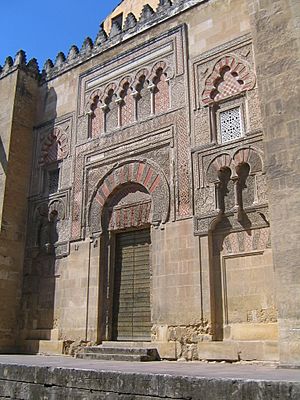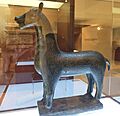Umayyad state of Córdoba facts for kids
Quick facts for kids
Umayyad state of Córdoba
|
|||||||||||||
|---|---|---|---|---|---|---|---|---|---|---|---|---|---|
| 756–1031 | |||||||||||||
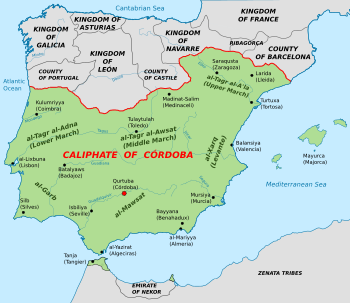
Caliphate of Córdoba circa 1000 AD
|
|||||||||||||
| Capital | Córdoba | ||||||||||||
| Common languages |
|
||||||||||||
| Religion | |||||||||||||
| Government | Islamic monarchy | ||||||||||||
| History | |||||||||||||
|
• Abd al-Rahman I proclaimed emir of Córdoba
|
756 | ||||||||||||
|
• Disintegrated into several independent taifa kingdoms
|
1031 | ||||||||||||
| Area | |||||||||||||
| 1000 est. | 600,000 km2 (230,000 sq mi) | ||||||||||||
| Population | |||||||||||||
|
• 1000 est.
|
10,000,000 | ||||||||||||
| Currency | Dirham | ||||||||||||
|
|||||||||||||
| Today part of | Gibraltar (UK) Morocco Portugal Spain |
||||||||||||
The Umayyad state of Córdoba was an important Arab Islamic state. It was ruled by the Umayyad dynasty from 756 to 1031. This state covered most of Iberia (modern-day Spain and Portugal) and parts of North Africa. Its capital city was Córdoba.
The state began in 756 as the Emirate of Córdoba. Later, in 929, Abd al-Rahman III took the title of caliph. This marked the start of the Caliphate of Córdoba.
The state was founded by Abd al-Rahman I. He was a prince from the Umayyad family who had to escape after his family was defeated. The state grew strong for almost 300 years. But in the early 11th century, a civil war broke out. This war was between the family of caliph Hisham II and his powerful court official, Al-Mansur. By 1031, the caliphate broke into many smaller independent Muslim kingdoms called taifas.
During this time, trade and culture grew a lot. Many famous buildings, like the Great Mosque of Cordoba, were built.
Contents
Political History: How Córdoba Was Ruled
Early Days: The Visigothic Kingdom
Before the Umayyads, the Visigothic Kingdom ruled Iberia for over 200 years. In 711, an army led by Tariq ibn Ziyad crossed from North Africa into southern Spain. They defeated the Visigoths at the Battle of Guadalete. The last Visigothic king, Roderic, was killed. This opened the way for the Umayyads to take over Iberia. They made it a province of their empire, with Córdoba as its capital.
The Emirate of Córdoba (756-929)
In 756, Abd al-Rahman I, a prince from the Umayyad royal family, arrived in Iberia. His family had lost power in Damascus to the Abbasid Caliphate in 750. Abd al-Rahman I refused to accept the Abbasids' rule. He defeated the local Muslim rulers and united many small areas into an independent emirate. It took him over 25 years to bring all of al-Andalus under his control.
For about 150 years, Abd al-Rahman I's family ruled as emirs of Córdoba. They controlled most of al-Andalus and sometimes parts of North Africa. However, their real power varied, especially near the Christian borders. For example, Emir Abdullah ibn Muhammad al-Umawi (around 900 AD) only controlled Córdoba itself.
The emirate also expanded through raids. For instance, they raided Corsica in 806. In 818, people in a suburb of Córdoba revolted against Emir Al-Hakam I. After the revolt was stopped, many people were forced to leave. Some settled in Fez or Alexandria, and others even formed the Emirate of Crete.
The emirs built strong armies. Abd al-Rahman I used a permanent army of 40,000 soldiers to stop conflicts. Later, Emir Al-Hakam I created a special guard of 5,000 soldiers, many of whom were Slavic slaves. Under Emir Muhammad I, the army grew to 35,000 to 40,000 fighters.
The Caliphate of Córdoba (929-1031)
Abd al-Rahman III became ruler in 912. He faced a powerful rival, the Fatimid Caliphate, a Shiʿite Islamic empire in North Africa. The Fatimids claimed to be the true caliphs, challenging the religious authority of the Abbasids. To show his own power and religious authority, Abd al-Rahman III took the title of caliph in 929. This meant he saw himself as the leader of all Muslims, even more important than the Abbasids.
Abd al-Rahman III stopped Fatimid invasions by taking control of important cities like Melilla (927), Ceuta (931), and Tangier (951) in North Africa. He also made alliances with Berber tribes and Christian kingdoms to the north. His army grew to between 30,000 and 50,000 troops.
Under Abd al-Rahman III, the caliphate became very rich. Public income was high, and this wealth was used to pay the army, maintain public buildings, and support the caliph.
His son, Al-Hakam II, took over in 961. Al-Hakam II continued his father's policies. He was more interested in learning and books than ruling. Because of this, the caliphate reached its peak in knowledge and scholarship under him.
Almanzor's Reforms
When Al-Hakam II died in 976, his young son Hisham II became caliph. However, the real power was held by Al-Hakam's top advisor, Almanzor. Almanzor made Hisham II a figurehead, meaning Hisham was caliph in name only.
Almanzor made many changes to the army. He made it more professional, meaning soldiers were paid and trained full-time. This helped him control the capital and have forces for many campaigns. He also brought in many Berbers from Africa to increase his support. Almanzor also changed the army's structure, mixing units instead of having them based on tribes.
These changes cost a lot of money. So, Almanzor often led campaigns to get loot and land to pay his troops. He also used Christian soldiers in his personal guard, even for campaigns against Christian lands.
Estimates of Almanzor's army size vary greatly. Some old stories say his armies had hundreds of thousands of soldiers. More modern studies suggest his armies were likely between 50,000 and 90,000. The main fighting force was light cavalry, which was fast and good for surprise attacks.
Córdoba also had a strong military industry. It produced many bows, arrows, and shields every month. The navy was used to transport troops, especially between North Africa and Iberia. It also protected the coasts from attacks.
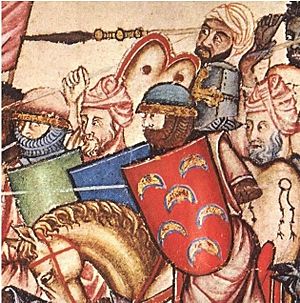
Almanzor removed anyone who might oppose him. He replaced governors and even poisoned the admiral of the fleet to put his own loyal people in charge.
The Collapse of the Caliphate
After Almanzor died in 1002, the power he had built started to fall apart. His sons tried to keep control, but there were many fights among military and political groups.
In 1009, Almanzor's son, Abd al-Rahman Sanchuelo, was killed during a revolt in Córdoba. This marked the beginning of the Fitna of al-Andalus, a civil war. Many people claimed to be the new caliph, and violence spread. The caliphate became weak and in 1031, it broke into many independent kingdoms called taifas. These included the Taifa of Córdoba, Taifa of Seville, and Taifa of Zaragoza. The last caliph of Córdoba was Hisham III (1027–1031).
Society and People
Under Umayyad rule, many people in al-Andalus started to speak Arabic and follow Islam. These became key parts of their identity.
Population and Cities
The capital city, Córdoba, was huge. In the 10th century, it likely had over 100,000 people, making it one of the largest cities in Europe. Some estimates say it had around 450,000 people around the year 1000. The entire caliphate had about three million people.
Other large cities included Toledo, Almería, and Granada, each with around 30,000 people. Zaragoza, Valencia, and Málaga had over 15,000. This was very different from the Christian areas to the north, which had no big cities.
Languages Spoken
Arabic became very important. Classical Arabic was used for government and literature. Over time, a local version called Andalusi Arabic developed. In the 9th century, people in the countryside still spoke Romance languages, but Arabic became the language of the middle and upper classes. By the end of the century, even Christians spoke Arabic so much that their religious texts had to be translated into it.
Who Lived in al-Andalus?
The population of al-Andalus was made up of several groups:
- Arabs: They were a minority but held the most power since the Muslim conquest.
- Berbers: They formed most of the conquering army and were a large group, though less powerful than the Arabs.
- Indigenous Converts (Muwallads): These were local Iberians who converted to Islam. They became very numerous over time. Some came from the old Visigothic noble families.
- Indigenous Christians: Their numbers decreased as more people converted to Islam.
- Jews: They were a smaller group but gained more freedom and a higher social standing under Umayyad rule compared to before.
People's identity was often linked to their family history. Arab identity was usually passed down through the father.
Religion and Beliefs
Islam
In Islamic matters, religious scholars (ulama) and judges (fuqaha) were very important. The Umayyads mainly supported the Maliki school of Islamic law. This helped Islam spread and became a key part of Andalusi identity.
Christians and Jews
Christians and Jews were considered "People of the Book" by Muslims. They were "protected non-Muslims" (dhimmis). In return for protection, they had to pay a special tax called the jizya. They could practice their religions, but they were not allowed to show their faith too openly, like ringing loud church bells.
Christians in al-Andalus were later called Mozarabs. This term means "Arabized" and refers to Christians who lived under Muslim rule. They spoke a local Romance dialect called Mozarabic.
Jews had a better life under Umayyad rule than before. They gained more freedom and became more important in society. Some Jews, like Hasdai ibn Shaprut, even worked in the caliph's court. He helped start a "Golden Age of Jewish culture" in the region.
Converting to Islam
Many native Iberians converted to Islam over time. People likely converted for social and economic reasons. As more people converted, it became more common. Important families were often among the first to convert to keep their status. As Islamic rule became permanent, more Christians converted to improve their social standing and find better jobs.
One study suggests that by 900, about 25% of the local population had converted. By 950, it was around 50%, and by 1000, about 75%.
Social Standing
The most powerful people in Córdoba were called the khāṣṣa. They were mostly Arabs, but some non-Arabs also joined them. Slaves were also part of society. Al-Andalus was a big center for the slave trade. Slaves were often used in rich homes and the royal court. Many were captured from Christian kingdoms or brought from other parts of Europe. These European slaves were called ṣaqāliba and were highly valued. Some were even trained as soldiers.
Women, especially those in the royal court, could be very powerful. Slave girls often received a good education in arts and literature.
Economy and Trade
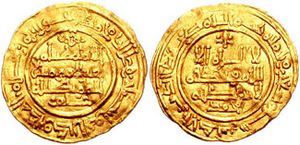
By the end of the 8th century, money was widely used in al-Andalus. In the 10th century, both gold and silver coins were made, thanks to gold coming from trade across the Sahara Desert.
The state also earned a lot from trade with other Islamic lands. Al-Andalus exported fine goods like silk cloth. It also sent raw materials to North Africa and the Middle East, which helped its economy grow. Córdoba also received money and slaves as tribute from the Christian kingdoms to the north.
Jewish merchants were very important in trade. They had large trade networks across the Mediterranean Sea. They often relied on family connections to build trust for payments, as there was no international banking system then.
The "agricultural revolution" was very important. New crops like rice, hard wheat, bananas, watermelons, and oranges were introduced. New irrigation methods, like using norias (waterwheels), also helped. This meant more food was grown, and it was available for longer parts of the year. This made the population healthier and richer.
Culture and Learning
In high society, both men and women were expected to learn adab, which was a type of good manners and culture. Women, especially royal concubines, were sometimes sent away to be trained in adab and other cultural skills.
Al-Andalus was influenced by cultures from the East, especially from Syria and Baghdad. The musician Ziryab was a famous trendsetter. He created new styles in fashion, hairstyles, and hygiene. His students spread these trends across Europe and North Africa. He also started an academy for arts, music, and fashion.
Literature and Scholarship
Córdoba was a major center for culture and learning. Ancient Greek texts were translated into Arabic, Latin, and Hebrew. Emir Abd al-Rahman II sent people to other courts to bring back books on Islamic studies, Arabic grammar, poetry, and science. Abbas ibn Firnas was a famous poet and scholar who brought back scientific knowledge from the East.
In the 10th century, Córdoba became one of the most important cultural centers in the Islamic world. Its wealth attracted travelers, diplomats, and scholars. There were many advances in science, history, geography, and philosophy. Caliph Al-Hakam II's royal library had an amazing 400,000 to 500,000 books. For comparison, a large monastery library in Switzerland at the time had only about 100 books.
Poets like Ibn Darraj al-Qastalli wrote for the caliph's court. A new type of poetry called Muwashshah, which mixed Arabic and Romance languages, became popular. Writers also started to write histories of the Umayyad dynasty in al-Andalus.
Christians and Jews also contributed to the intellectual life. Hasdai ibn Shaprut, a Jewish scholar, was very important. He helped make the Jewish community in al-Andalus independent from other Jewish centers, leading to a "Golden Age of Jewish culture".
Some upper-class women also received education. They wrote poetry, copied the Qur'an, and even founded libraries. Lubna, a slave, worked as a scribe and librarian for Al-Hakam II. Some female slaves were educated in subjects like calligraphy, astronomy, and medicine.
Arts and Crafts
In the 10th century, the caliph's workshops in places like Madinat al-Zahra made beautiful luxury items. These were used at court or given as gifts to important guests. Many of these objects are now in museums and cathedrals in Europe.
Famous examples include carved ivory boxes with plants, figures, and Arabic writing. The Pyxis of al-Mughira and the Leyre Casket are well-known. The workshops also made fine silks, ceramics, and leather goods. A famous bronze fountain spout shaped like a stag, called the "Stag of Córdoba," was made at Madinat al-Zahra.
Marble was also used for decoration in buildings, like wall panels and window grilles. Carved marble capitals (the tops of columns) were very popular. They had beautiful Islamic plant designs.
Architecture: Famous Buildings
Emirate Period Buildings

Abd al-Rahman I first lived in palaces outside Córdoba. Later, he moved to the Alcázar inside the city. He and his family kept building and improving the Alcázar as their royal home. Abd al-Rahman II improved the water supply for the city and palace gardens. He may have also built waterwheels along the Guadalquivir River.
In 785, Abd al-Rahman I started building the Great Mosque of Cordoba. This is one of the most important buildings in Islamic architecture. It is famous for its large hall with many columns and double arches made of red brick and light stone. Later emirs, like Abd al-Rahman II, expanded the mosque, keeping its original design.
The palaces and the Great Mosque were connected by a high covered walkway called a sabbat. This allowed the caliph to go directly from his palace to the mosque safely.
Caliphal Period Buildings
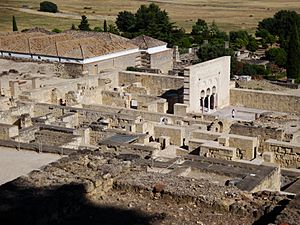
Abd al-Rahman III showed his power by building a huge and beautiful palace-city called Madinat al-Zahra just outside Córdoba. Construction started around 936 and continued during his rule and his son's. This new city had grand halls, a mosque, offices, homes, gardens, workshops, and baths.
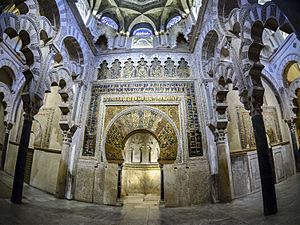
He also expanded the courtyard of Córdoba's Great Mosque and built its first true minaret (a tower for the call to prayer). This square-shaped minaret set a style for other mosques in the region. His son, Al-Hakam II, further expanded the mosque's prayer hall in 962. He added beautiful features like interlacing arches, decorated domes, and a richly decorated mihrab (a niche showing the direction of prayer) with gold mosaics.
A smaller but important mosque from this time is the Bab al-Mardum Mosque in Toledo. It has interesting ribbed domes and Arabic writings carved in brick. Other buildings from this period include old city gates in Toledo, the former mosque of Almonaster la Real, and the Caliphal Baths of Córdoba.
In North Africa, the Umayyads also influenced architecture. They expanded the Qarawiyyin and Andalusiyyin mosques in Fes, adding square minarets like the one in Córdoba.
List of Rulers
Images for kids
-
The Pyxis of al-Mughira, a carved ivory casket made at Madinat al-Zahra dated to 968
-
Plant designs and figures carved in ivory on the Leyre Casket, made in 1004–1005
See also
 In Spanish: Emirato de Córdoba para niños
In Spanish: Emirato de Córdoba para niños
- History of Islam
- History of Gibraltar
- History of Algeria
- History of Portugal
- History of Morocco
- History of Spain
- List of Sunni Muslim dynasties
- Martyrs of Córdoba
- Timeline of Septimania
- Umayyad conquest of Hispania
- Reconquista
- Sara al-Qutiyya


